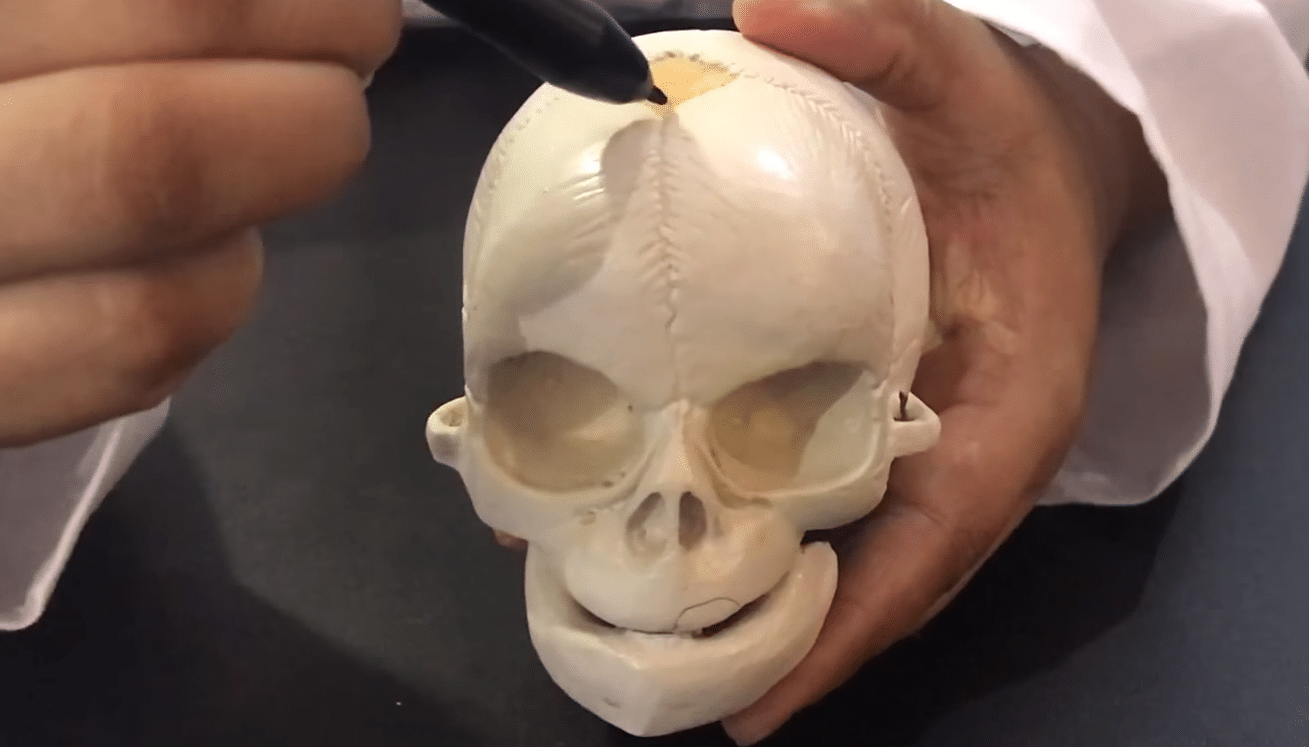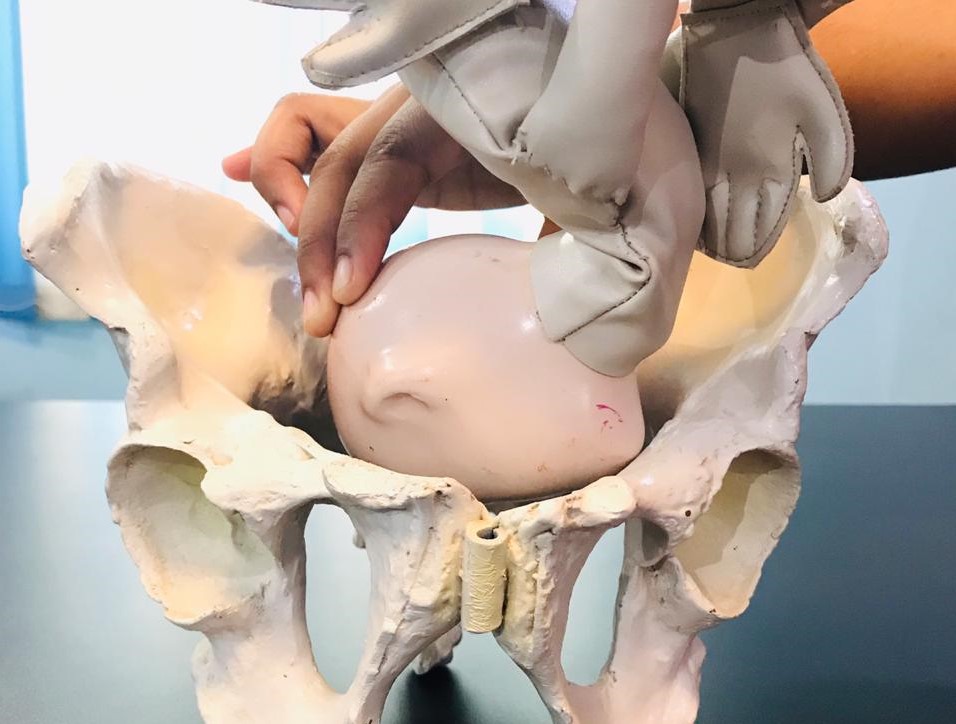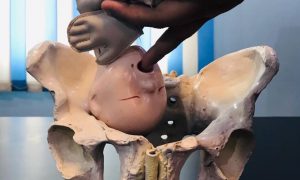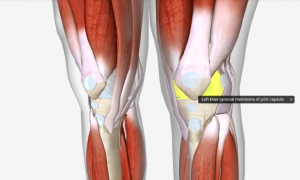It contains a delicate brain that is large in relation to the fetal body & in comparison with the mother’s pelvis, therefore, some adaptation between skull & pelvis must take place during labour. The head is the most difficult part to be born whether it comes first or last.
Bones of the vault-
OCCIPITAL
Lies at the back of the head & forms the region of occiput. Part of it contributes to the base of the skull, as it contains the foramen magnum, which protects the spinal cord as it leaves the skull. At the center is an occipital protuberance.
PARIETAL BONE(2)
Lies on either side of the skull, ossification center of each called the parietal eminence.
FRONTAL BONE(2)
These form the forehead or sinciput. At the center of each is the frontal eminence. It fuses into a single by 8 yrs. of age.
In addition to these 5, the upper part of the temporal bone is flat and forms a small part of the vault.
Sutures –
Sutures are cranial joint & formed where 2 bone adjoins.
- Lambdoidal suture- This separates the 2 parietal bones from the occiput bone.
- Sagittal suture- Lies between 2 parietal bones.
- Coronal suture- This separates the frontal bone from the parietal bone passing from one temple to another.
- Frontal suture- This runs between the 2 halves of the frontal bone.
- Squamous suture- Lies between the temporal and parietal bone.
FONTANELLES –
Where 2 or more sutures meet, a fontanelle is formed.
Anterior Fontanelle & Bregma-
This is found at the junction of sagittal, coronal, and frontal sutures. It is broad kite-shaped and it measures 3-4 cm long and 1.5-2 cm wide and normally closes by 18 months.
Posterior Fontanelle / Lambda- (shape greek like λ )
This is situated at the junction of the lambdoidal and sagittal sutures. It is a small triangular shape. It closes by 6 weeks of age.
And the other 2 with less obstetrical significance is anterolateral (Sphenoid) and posterolateral fontanelles (Mastoid).
Regions/ Areas-
The skull is divided into 3 parts with obstetrical importance.
- Vertex- This is bounded by posterior fontanelle, 2 parietal eminences & by the anterior fontanelle. When the head is flexed well, suboccipitobregmatic & the biparietal diameter present. As both are of the same length 9.5 cm. The presenting area is circular.
- Brow/Sinciput- This extends from the anterior fontanelle & the coronal suture to the orbital ridges. When the head is partially extended, the mentovertical diameter(13.5cm.) & if this presentation persists, vaginal delivery unlikely.
- Face- The face is small in the newborn baby. It extends from the orbital ridges & root of the nose to the junction of chin & the neck. The point between the eyebrows known as glabella. The chin termed as mentum.
Moulding
This term applied to the change in the shape of the fetal head that takes place during its passage through the birth canal.
Alteration in shape is possible because the bones of the vault allow a slight degree of bending and the skull bone is able to override the sutures. The overriding allows a considerable reduction in the size of the presenting diameter.
Moulding is a protective mechanism and prevents the fetal brain from being compressed. The skull of a preterm infant, being softer & often and having wider sutures, may mould excessively, the skull of a post-term infant does not mould well and have greater hardness.
Diameters of the fetal skull
The measurement of the skull is important to understand the relationship between the fetal head and the mother’s pelvis.
The anteroposterior diameter which may engage are-
- Suboccipitobregmatic (9.5 cm)- The diameter from below the occiput protuberance to the center of anterior fontanelle or bregma.
- Suboccipitofrontal (10 cm)- This is from below the occiput protuberance to the center of a frontal suture.
- Occipitofrontal (11.5 cm)- The diameter from the occipital protuberance to glabella.
- Mentovertical (13.5 cm)- The diameter from the point of the chin to the highest point of a vertex.
- Submentovertical (11.5 cm)- The diameter from the point where the chin joins the neck to the highest point of a vertex.
- Submentobregmatic (9.5 cm)- The diameter from the point where the chin joins the neck to the center of the bregma.
The transverse diameter which may engage are-
- Biparietal diameter (9.5 cm)- The diameter between the 2 parietal eminences.
- Bitemporal diameter (8.2 cm)- The diameter between the furthest point of coronal suture at the temples.
- Super subparietal diameter (8.5cm)- It extends from a point placed below one parietal eminence to a point placed above the other parietal eminence of the opposite side.
- Bimastoid diameter (7.5 cm)- It is the distance between the tips of the mastoid processes.
Download the App: Android App
For more Lectures, please visit-
YouTube Channel – NursingLecture
Facebook – Facebook Page
Check out the Practical or Image-based videos of Fetal Skull here:






